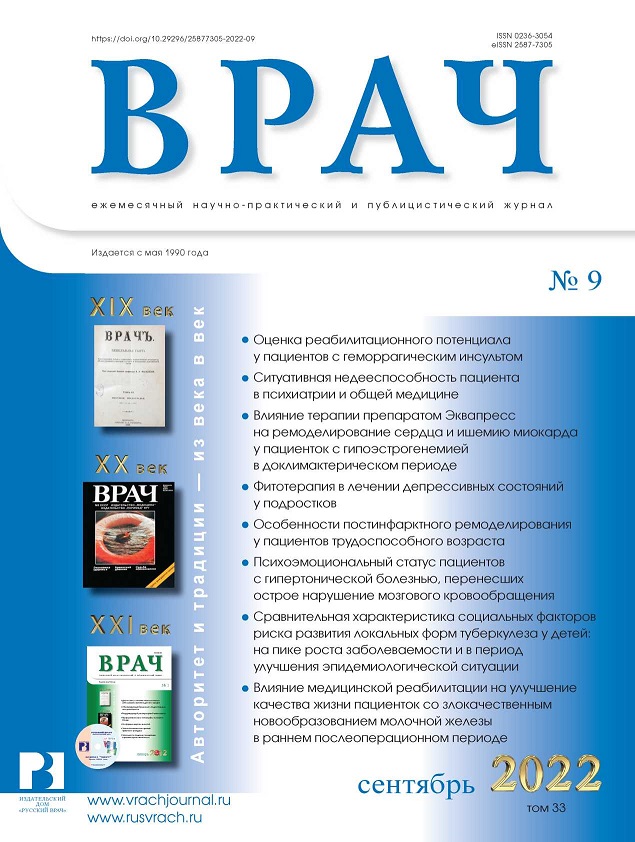Diastolic dysfunction in patients with acute coronary pathology in the presence of an increase in epicardial adipose tissue
- 作者: Davydova A.V.1, Nikiforov V.S.2, Khalimov Y.S.3
-
隶属关系:
- Kamchatka Territorial Hospital
- I.I. Mechnikov North-Western State Medical University, Ministry of Health of Russia
- S.M. Kirov Military Medical Academy, Ministry of Defense of Russia
- 期: 卷 33, 编号 9 (2022)
- 页面: 47-52
- 栏目: From Practice
- URL: https://journals.eco-vector.com/0236-3054/article/view/114687
- DOI: https://doi.org/10.29296/25877305-2022-09-09
- ID: 114687
如何引用文章
详细
Objective. To evaluate diastolic disturbances in patients with unstable angina (UA) in the presence of an increase in epicardial adipose tissue (EAT). Subjects and methods. The investigation involved 64 men and 38 women (mean age, 612+7.6 years) with UA treated in the emergency cardiology unit. The patients were examined; standard laboratory parameters were determined, coronary angiography (CAG) and stenting of one or more coronary arteries were performed on days 1-3 of hospitalization. Echocardiography (EchoCG) with measurement of EAT thickness (EATT) was done at 2-4 days after CAG. EAT was measured from the parasternal position along the long and short axes of the left ventricle (LV) at the end of systole during 3 cardiac cycles; the average of three successive values was taken as the EATT value. According to EATT, the patients were divided Into 2 groups: 1)46 patients who had an EATT of <7.6 mm; 2) 56 patients who had an EATT of >7.6 mm. Results.Analysis of anamnestic and anthropometric data showed no significant differences between the groups, with the exception of waist-to-hip ratio (higher in Group 1; p=0.0026). EchoCG revealed heart failure with preserved LV e/ection fraction (EF); however, LV EF had lower values In Group 2 than In Group 1 (55 [51-59]% versus 58 [53-60]%; p=0.031). There was a significant decrease In the following indicators of diastolic function (DF) in Group 2 compared to Group 1: lateral Em was 6.5 (4.2-8.1) versus 9.3 (6.5-11.1) cm/s (p<0.001); median Em was 5.7 (4.6-6.6) versus 7 (5.6-8.5) cm/s (p=0.001), a significant increase In DT was 228 [207-273] versus 178 [150-211] ms (p<0.001),as well as the E/Em ratio was 11.4 (8.3-14.9) relative units versus 8.7 (5.1-14.2) relative units (p=0.017). There was a positive correlation between EATT and DT (r=0.498; p=0.001) and a moderate negative correlation between EAT and lateral Em (r= -0.374; p = 0.001) and between EATT and median Em (r=-0.331; p=0.001). In Group 2, grade 2 DF disturbances were detected significantly more often (60.8% versus 30.5%; p=0.013). Thus, the individuals with UA were observed to have more pronounced DF disturbances with an increase in EATT. To evaluate diastolic disturbances in patients with acute coronary syndrome without ST segment elevation in the presence of an increase in EAT, it is advisable to use myocardial tissue Doppler EchoCG. The increased EATT In patients with UA should be considered as a possible adverse factor for myocardial dysfunction.
全文:
作者简介
A. Davydova
Kamchatka Territorial Hospital
编辑信件的主要联系方式.
Email: anna.pustovaya@gmail.com
Petropavlovsk-Kamchatsky
V. Nikiforov
I.I. Mechnikov North-Western State Medical University, Ministry of Health of Russia
Email: anna.pustovaya@gmail.com
доктор медицинских наук, профессор
Saint PetersburgYu. Khalimov
S.M. Kirov Military Medical Academy, Ministry of Defense of Russia
Email: anna.pustovaya@gmail.com
доктор медицинских наук, профессор
Saint Petersburg参考
- Барбараш О.Л., Дупляков Д.В., Затейщиков Д.А. и др. Острый коронарный синдром без подъема сегмента ST электрокардиограммы. Клинические рекомендации 2020. Российский кардиологический журнал. 2021; 26 (4): 4449. doi: 10.15829/1560-4071 -2021-4449
- Collet J.P., Thiele Н., Barbato Е. et al. ESC Scientific Document Group. 2020 ESC Guidelines for the management of acute coronary syndromes in patients presenting without persistent ST-segment elevation. Eur Heart J. 2021; 42 (14): 1289-367. DOI: 10.1093/ eurheartj/ehaa575
- Shao C. Wang J., Tian J. et al. Coronary Artery Disease: From Mechanism to Clinical Practice. Adv Exp Med Biol. 2020; 1177:1-36. doi: 10.1007/978-981 -15-2517-9_1
- Давыдова A.B., Никифоров B.C., Халимов Ю.Ш. Толщина эпикардиальной ткани как предиктор кардиоваскулярного риска. Consilium Medicum. 2018; 20 (10): 91-4. doi: 10.26442/2075-1753_2018.10.91 -94
- Lacobellis G., Willens H. Echocardiographic epicardial fat a review of research and clinical applications. J Am Soc Echocardiogr. 2009; 22 (12): 1311-9; quiz 1417-8. doi: 10.1016/j.echo.2009.10.013
- Lacobellis G., Assael F., Ribaudo M. et al. Epicardial fat from echocardiography: a new method for visceral adipose tissue prediction. Obes Res. 2003; 11 (2): 304-10. DOI: 10.1038/ oby.2003.45
- Villasante Fricke A., lacobellis G. Epicardial Adipose Tissue: Clinical Biomarker of Cardio-Metabolic Risk.Int J Mol Sd. 2019; 20 (23): 5989. doi: 10.3390/ijms20235989
- Никифоров B.C., Новиков В.И., Некина H.M. и др. Эхокардиографическая оценка систолической и диастолической функций сердца. СПб: КультИнформПресс, 2017; 36 с.
- Jadhav S.N., Radchenko V.G., Seliverstov P.V. etal. Importance of insulin resistance in patients with nonalcoholic fatty liver disease and diastolic dysfunction of the heart. Preventive and dinical medidne. 2019; 2 (71): 52-9.
- Хабибуллина М. Терапия при ремоделировании сердца у молодых мужчин с АГ, андрогенодефицитом и дислипидемией. Врач. 2019; 30 (3): 44-9. D01:10.29296/25877305-2019-03-09
- Коерр К., Obokata М., Reddy Y. et al. Hemodynamic and Functional Impact of Epicardial Adipose Tissue in Heart Failure With Preserved Ejection Fraction. JACC Heart Fail. 2020; 8 (8): 657-66. doi: 10.1016/j.jchf.2020.04.016
- Дедов Д.В., Иванов А.П., Эльгардт И.А. Влияние электромеханического ремоделирования сердца на развитие фибрилляции предсердий у больных ИБС и артериальной гипертонией. Российский кардиологический журнал. 2011; 4:13-8.
- Russo R., Di lorio В., Di Lullo L. et al. Epicardial adipose tissue: new parameter for cardiovascular risk assessment in high-risk populations. J Nephrol. 2018; 31 (6): 847-53. doi: 10.1007/S40620-018-0491 -5
- Lacobellis G. Local and systemic effects of the multifaceted epicardial adipose tissue depot Nat Rev Endocrinol. 2015; 11 (6): 363-71. doi: 10.1038/nrendo.2015.58
- Vural М., Talu A., Sahin D. et al. Evaluation of the relationship between epicardial fat volume and left ventricular diastolic dysfunction. Jpn J Radiol. 2014; 32 (6): 331-9. doi: 10.1007/s11604-014-0310-4
- Nakanishi K., Fukuda S., Tanaka A. et al. Relationships Between Periventricular Epicardial Adipose Tissue Accumulation, Coronary Microcirculation, and Left Ventricular Diastolic Dysfunction. Can J Cardiol. 2017; 33 (11): 1489-97. doi: 10.1016/j.cjca.2017.08.001
补充文件





